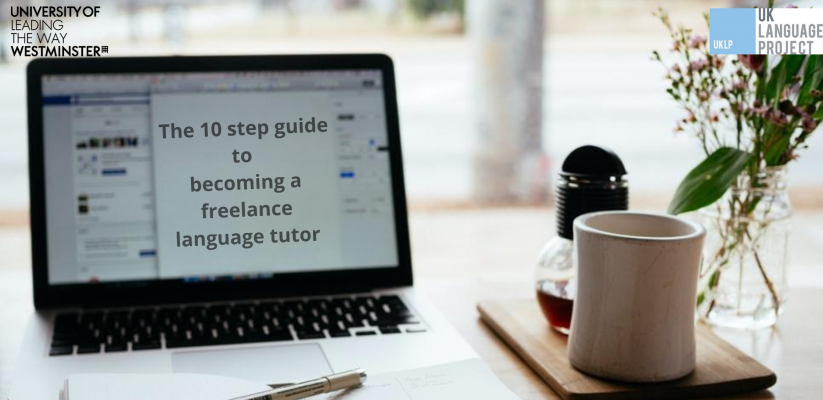The world of freelance work can be overwhelming at first. To help you, we’ve put together a summary of our 10 steps to starting out on your career as a freelance language teacher.
For a deeper dive into the 10 steps, take a look at the ultimate guide to starting your career as a freelance language teacher on the UK Language Project blog.
💡 Step 1: Decide which language to teach
A good start would be your native language. Or perhaps you’d like to continue with a language you learned at Uni? You can help others learn while keeping your skills fresh as well. As long as you have at least C1 (advanced) level proficiency you’re good to go.
💡 Step 2: Decide on your ideal students and how you’re going to deliver your lessons
• Ideal students – Children, adults, teens, business people. There are lots of options. It’s best to narrow things down to at least children vs adults. You’ll save yourself time and effort buying materials and planning lessons and courses.
• Delivery of lessons – A huge amount of learning is now online. This trend is going nowhere. Does online suit you? Or do you prefer a mix of both on and offline. Or even just going down the face to face route if it’s safe to do so.
💡 Step 3: Offer to teach for free and do language exchanges
• Teaching for free – Do you know any friends or family who want to learn the language you’re looking to teach? Ask them if they’d be willing to be your ‘guinea pigs’ for your first lessons. You can even advertise on noticeboards at the Uni to see if there are any takers.
• Language exchanges (aka intercambio) – If you’re looking to learn/improve in another language this can be the way. Find an exchange partner (the Uni can help you with this) You teach your partner for an hour, your partner teaches you for an hour. You both improve your language and teaching skills at the same time.
💡 Step 4: Gain a qualification
If you decided to teach English as a foreign language (EFL) in step 1 then a Cambridge CELTA qualification is definitely recommended. The best way is to do the 4 week intensive CELTA which includes an expert who will observe and critically analyse your teaching. Essential if you’re to make improvements in a short time.
For other languages don’t worry about a qualification at this time. Your degree will be sufficient.
💡 Step 5: Get your pricing, equipment and payments policies in order
• Pricing: Be careful here. It takes a second to lower your prices. It takes a lifetime to put them up. Be realistic about your prices and do your research. But don’t undercut or discount. You haven’t spent all these years in education to charge rock-bottom prices!
• Equipment: If you’re doing the online thing a headset, microphone and high-quality camera are a must. It’s difficult to set yourself apart from the rest online. Quality is one way.
• Payment policies: For your own private students we recommend taking payment for blocks of hours in advance, with a 24 hour cancellation policy. Don’t let students ‘pay as they go’ as this can devastate your income if too many cancel (which they will!)
💡 Step 6: Register at various tutoring marketplaces
There are a lot of these. We’ve gone over the best to start out on, as well as best practices for setting up and maintaining your profile in the ultimate guide to starting your career as a freelance language teacher, on the UK Language Project blog.
💡 Step 7: Once you have students – keep teaching!
When you’re inexperienced what’s the most difficult thing to get? Experience! So once you’ve got a few students work them. Go out of your way with your lessons and support for a few months. Really get through those first few months and into a more experienced position as fast as you can.
💡 Step 8: Obtain between 5 and 10 marketplace reviews
Study after study has shown that most people don’t read beyond 10 reviews. But will read up to review 10. Ask your students to leave 5-star reviews for you and make sure you check to make sure they actually have done.
💡 Step 9: Keep doing what works, ditch what doesn’t
If you treat your first few months of teaching as a bit of R&D you’ll be fine. Some lessons won’t work. Some will work great. Others you’ll have to tweak and tailor to the student. Keep learning and reviewing each lesson you do so you get better with each one.
You won’t have to do this for ever, but in the first few months it’ll push you to the next level.
💡 Step 10: Look beyond the marketplaces
So you’ve done a year or so freelance tutoring and you like it. Now is the time to look beyond the marketplaces and experiment on your own. Language agencies and schools who take on freelancers can be a great mix. They can offer more financial security as well as removing quite a lot of admin.
There we go. Follow these steps and you’ll do great in your chosen path!
☞ A big thank you to Ed from the UKLP team for writing this blog! We hope you all find it useful.☜
If you need careers support, your Careers Team is only an email / a message away!
E: careers@westminster.ac.uk| Website | Facebook | Twitter | Instagram |Careers Blog
- An End-to-End Guide to Applying for Jobs: Where and When to Start! - 22 December 2025
- Graduate Success Series: a conversation with Ying Zhang - 18 December 2025
- Why Purpose is Your Greatest Asset in Higher Education - 23 October 2025
